Blogger’s rainforest and climate claims ‘uninformed’ and ‘ridiculous’ say scientists.
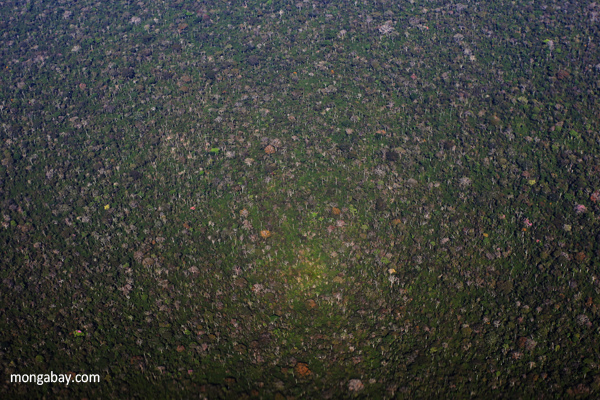
Amazon rainforest in Peru.
Recent blog posts on The Telegraph and the Register claiming that tropical rainforests like the Amazon are set to benefit from climate change are “uninformed” and “ridiculous” according to some of the world’s most eminent tropical forest scientists.
The posts, published Sunday and Monday by Tim Worstall, a Senior Fellow at London’s Adam Smith Institute, asserted that a new Nature study indicates that “climate change will mean new and larger tropical forests.”
“We’re told, endlessly, that climate change will mean the end of the Amazon, of the tropical forests, and the Earth will lose its lungs,” he wrote. “It appears that this is not wholly and completely true. Actually, an increase in CO2 in the atmosphere is likely to lead to the growth of huge, new, tropical forests.”
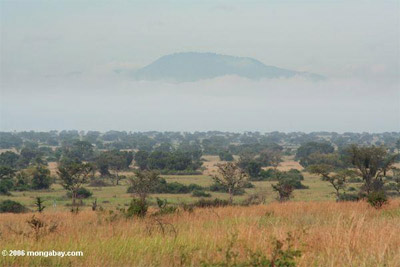 African woodland-savanna in Uganda with the Rwenzori Mountains mountains in the background. Photo by Rhett A. Butler. |
The paper in question looks specifically at the potential impacts of higher carbon dioxide levels on plant growth in the savannas of Africa. It found that elevated CO2 levels may favor so-called C3 plants like trees over C4 plants like grasses, leading to more trees sprouting up across Africa’s grasslands and potentially more African woodlands.
Worstall extends the findings to argue that increased carbon levels will suddenly cause new rainforests to emerge worldwide.
“The major point of this paper is that far from climate change being a threat to the tropical forests, it looks as if it will be the cause of more of them growing,” he writes on The Register.
“Burning more fossil fuels therefore seems likely to grow several new Amazon style forests across Africa and Latin America,” he adds on The Telegraph’s finance blog.
But some of the world’s leading tropical forest experts took aim at Worstall’s logic, noting the limitations of the study as well as the other factors that are endangering rainforests.
“This is a typically uniformed piece by Tim Worstall. After confusing Amazon rainforests and African savannas, he implies that scientists only report on what he calls negatives, such as the impacts of extreme droughts on tropical forests, and not on what he calls positives, like carbon dioxide increasing plant growth. A simple call to a scientist working in the area could have pointed him to papers showing both things. Simpler still he could have read the newspaper website he writes for, where both drought and carbon dioxide impacts have been reported,” Simon Lewis, a tropical forest expert at the University of Leeds, told mongabay.com.
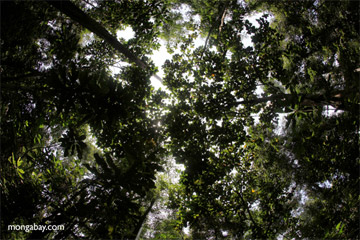 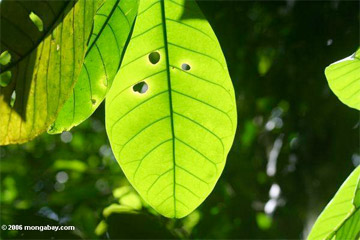 Rainforest in Africa (top) and Indonesia (bottom). Photos by Rhett A. Butler. |
Lewis, who led one of the most extensive studies of carbon uptake in tropical forests, explained that while there is evidence that more trees are growing across the drier parts of Africa, it doesn’t mean rainforests are poised to expand.
“Growth of new tropical forests depends on vegetation responses to multiple changes in the environment and complex feedbacks. Increasing carbon dioxide amounts in the atmosphere tends to increase tree growth, but higher air temperatures tends to reduce growth. Droughts and associated fires kill trees,” he said, adding that the new scientific paper that Wortall cites ignored the effects of drought, which would reduce tree growth.
“A common view within the scientific community is that at higher carbon dioxide concentrations, if business as usual emissions continue, eventually tropical trees will become saturated with carbon dioxide, and at much higher temperatures, photosynthesis may well decline, and there will be more fires and droughts which combined may reduce overall tree growth and increase tree deaths. This net impact is not a panacea for tropical forests. Even a rudimentary grasp of the scientific literature would show that Tim Wortall’s dramatic statement is a fairly wild extrapolation from a single scientific paper.”
Greg Asner, an ecologist with the Carnegie Institution who has done advanced assessment of the impact of droughts across the Amazon, agreed with Lewis.
“Worstall has taken a single study on a single component process (CO2 uptake) in a very different ecosystem and extrapolated it to a totally different biome encompassing all processes at a global scale, and then he proceeded to concoct an interpretation of that study that is inconsistent with what is happening at the large scale in the tropics,” he told mongabay.com.
“The real problem here is physiology, time and scale,” Asner continued. “Sure, you can feed someone more and more donuts and they might gain the weight, but cut off their water repeatedly, and gradually increase the temperature in the room, and those poor souls will keel over, just more dramatically with all those extra donuts ingested. That’s exactly what is happening with climate change in the humid tropics. Yes, the trees are getting more CO2 in the background, but in the foreground are these repeated droughts and constantly increasing nighttime temperatures that pull the vegetation back, and to the ground. We are still trying to assess the longer-term effects of the 2010 drought in the Western Amazon, but there’s no sign that the forests did ‘well’.”
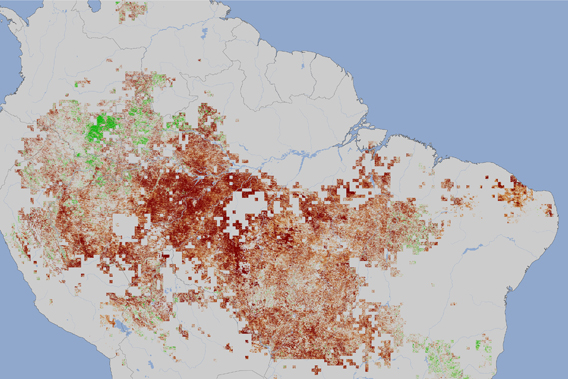
Image from the Moderate Resolution Imaging Spectroradiometer (MODIS) on NASA’s Terra satellite, showing vegetation ‘greenness’ during the Amazon’s 2010 drought. Image courtesy of NASA.
In fact, drought and other factors are triggering the opposite of the picture painted by Wortall, according to Eric Davidson, Executive Director and Senior Scientist at the Woods Hole Research Center in Massachusetts. Earlier this year Davidson led a review of 100 studies looking at the effects of disturbance and climate change on the functioning of the Amazon Basin. It concluded that the combination of deforestation, forest degradation, and the effects of climate change are weakening the resilience of the Amazon ecosystem, potentially leading to loss of carbon storage and changes in rainfall patterns and river discharge. Among the changes was a shift from rainforest to savanna.
“As our review paper in Nature earlier this year describes, the transition forest on the southern flank of the Amazon is showing a transition from forest to savanna. So, just the opposite from what he describes is currently happening. The southern Amazon transition forest is experiencing more drought, longer dry seasons, and more fire. Wet season river flooding and sedimentation has also increased in this region — another indicator of forest decline. While increasing CO2 concentrations can increase productivity of many plants, drought and fire are the big determinants of tree growth in the southern Amazon.”
“Worstall’s rant about widespread Amazon forest dieback reinforces my view that this is a distraction — let’s look at the evidence at hand where forest meets savanna — it is moving more towards savanna, not towards more forest.”
Dan Nepstad, Director at the Amazon Environmental Research Institute (IPAM), agreed.
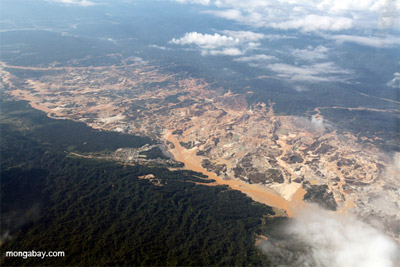 Deforestation in the Peruvian Amazon. In his column, Worstall belittled the risks of deforestation to tropical forests, writing “Good news for those of us who like our unsustainable tropical hardwood furniture: it looks like there’s going to be a lot more of it to go around soon enough.” Worstall also exaggerates proposed solutions for reducing greenhouse gas emissions: “Of course what we’re told we have to do about it, closing down industrial civilization, is simply crazed lunacy. Better to lose all the forests than have to return to rural peasantry for all.” |
“After studying the Amazon rainforest for 28 years, it is clear that one third or more of this mighty ecosystem is vulnerable to severe degradation through the interacting influences of devastating droughts, fire, forest conversion to crops and pastures, and logging. What is most worrisome is that this process of degradation is self-reinforcing — fire begets fire; drought begets drought. The severe weather episodes associated with climate change may already be pushing the forest-climate-fire system towards a tipping point of cascading forest degradation. These effects swamp the slightly faster growth rates that we are seeing in some Amazon trees that may be the result of higher CO2 levels.”
William F. Laurance, an ecologist at James Cook University in Australia, told mongabay.com that these other factors make it far too soon to begin assuming tropical forests are set to expand.
“Mr Worstall’s comments are a bit ridiculous, really,” said Laurance. “Yes, it’s true that, where disturbances are limited, rising CO2 levels might help give trees a competitive edge with grasses. And it’s also true that some tropical forests are slowly getting more massive, quite possibly because of CO2 fertilization.”
“But to suggest this means our worries for rainforests are over is patently silly. There are a whole constellation of factors—such as bulldozers, fires, chainsaws, and rapidly expanding road networks—that are knocking down rainforests every day. Forest destruction is happening a whole lot faster than forest expansion.”
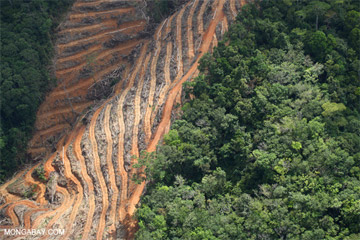 Deforestation for palm oil production. Photo by Rhett A. Butler. |
“We live in an era of rapidly shrinking rainforests, and all signs suggest that is only going to continue, especially in a world with up to 10 billion people in it.”
Worstall’s editorials come two years after Jonathan Leake, Science & Environment Editor of the Sunday Times, triggered the “Amazongate” scandal when he claimed that studies forecasting a potential die-off of the Amazon rainforest were “bogus”. Scientists quickly refuted the story and a subsequent investigation revealed the die-off scenario was indeed backed by scientific research. The debacle led to Sunday Times retracting the piece and issuing an apology, acknowledging journalistic misconduct in the handling of the story.
Related articles
Deforestation, climate change threaten the ecological resilience of the Amazon rainforest
(01/19/2012) The combination of deforestation, forest degradation, and the effects of climate change are weakening the resilience of the Amazon rainforest ecosystem, potentially leading to loss of carbon storage and changes in rainfall patterns and river discharge, finds a comprehensive review published in the journal Nature.
Breakthrough technology enables 3D mapping of rainforests, tree by tree
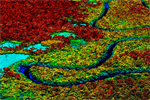
(10/24/2011) High above the Amazon rainforest in Peru, a team of scientists and technicians is conducting an ambitious experiment: a biological survey of a never-before-explored tract of remote and inaccessible cloud forest. They are doing so using an advanced system that enables them to map the three-dimensional physical structure of the forest as well as its chemical and optical properties. The scientists hope to determine not only what species may lie below but also how the ecosystem is responding to last year’s drought—the worst ever recorded in the Amazon—as well as help Peru develop a better mechanism for monitoring deforestation and degradation.
Climate change and deforestation pose risk to Amazon rainforest

(05/20/2011) Deforestation and climate change will likely decimate much of the Amazon rainforest, says a new study by Brazil’s National Institute for Space Research (INPE) and the UK’s Met Office Hadley Centre. Climate change and widespread deforestation is expected to cause warmer and drier conditions overall, reducing the resistance of the rainforest ecosystem to natural and human-caused stressors while increasing the frequency of extreme rainfall events and droughts by the end of this century. While climate models show that higher temperatures resulting from global climate change will threaten the resilience of the Amazon, current deforestation is an immediate concern to the rainforest ecosystem and is likely driving regional changes in climate.
NASA image reveals extent of 2010 Amazon drought
(04/17/2011) NASA has revealed a satellite image of the crippling effect of last year’s record-breaking drought on the Amazon ecosystem. For those of you counting, that’s two record droughts in the Amazon Basin in 5 years.
Last year’s drought hit Amazon hard: nearly a million square miles impacted
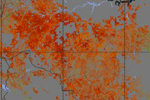
(03/29/2011) A new study on its way to being published shows that the Amazon rainforest suffered greatly from last year’s drought. Employing satellite data and supercomputing technology, researchers have found that the Amazon was likely hit harder by last year’s drought than a recent severe drought from 2005. The droughts have supported predictions by the Intergovernmental Panel on Climate Change’s (IPCC) that climate change, among other impacts, could push portions of the Amazon to grasslands, devastating the world’s greatest rainforest. “The greenness levels of Amazonian vegetation—a measure of its health—decreased dramatically over an area more than three and one-half times the size of Texas and did not recover to normal levels, even after the drought ended in late October 2010,” explains the study’s lead author Liang Xu of Boston University.
Two massive droughts evidence that climate change is ‘playing Russian roulette’ with Amazon
(02/03/2011) In 2005 the Amazon rainforest underwent a massive drought that was labeled a one-in-100 year event. The subsequent die-off of trees from the drought released 5 billion tons of CO2. Just five years later another major drought struck. The 2010 drought, which desiccated entire rivers, may have been even worse according to a new study in Science, adding on-the-ground evidence to fears that climate change may inevitably transform the world’s greatest rainforest.
Amazon suffers worst drought in decades
(10/24/2010) The worst drought since 1963 has created a regional disaster in the Brazilian Amazon. Severely low water levels have isolated communities dependent on river transport. Given a worsening situation, Brazil announced on Friday an emergency package of $13.5 million for water purification, tents, and food airdrops.
(06/21/2010) The Sunday Times over the weekend retracted a column that accused the Intergovernmental Panel on Climate Change (IPCC) of making a ‘bogus rainforest claim’ when it cited a report warning that up to 40 percent of the Amazon could be “drastically” affected by climate change. The ‘Amazongate’ column, authored by Jonathan Leake, Science & Environment Editor of the Sunday Times, was immediately seized upon by climate skeptics as further evidence to discredit the IPCC just two weeks after it was found to be using shoddy glacier data in its 2007 climate assessment. But now the Sunday Times has removed Leake’s column from its web site and issued on apology, admitting that the Amazon claim was indeed supported by scientific research. The Sunday Times also acknowledged misconduct in the way one of the story’s sources—Simon Lewis of the University of Leeds in Britain—was quoted.
Scientists: new study does not disprove climate change threat to Amazon
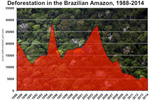
(03/19/2010) Recently, Boston University issued a press release on a scientific study regarding the Amazon’s resilience to drought. The press release claimed that the study had debunked the Intergovernmental Panel on Climate Change’s (IPCC) theory that climate change could turn approximately 40 percent of the Amazon into savanna due to declining rainfall. The story was picked up both by mass media, environmental news sites (including mongabay.com), and climate deniers’ blogs. However, nineteen of the world’s top Amazonian experts have issued a written response stating that the press release from Boston University was “misleading and inaccurate”.
Drought threatens the Amazon rainforest as a carbon sink

(03/05/2009) Drought in the Amazon is imperiling the rainforest ecosystem and global climate, reports new research published in Science. Analyzing the impact of the severe Amazon drought of 2005, a team of 68 researchers across 13 countries found evidence that rainfall-starved tropical forests lose massive amounts of carbon due to reduced plant growth and dying trees. The 2005 drought — triggered by warming in the tropical North Atlantic rather than el Niño — resulted in a net flux of 5 billion tons of carbon dioxide (CO2) into the atmosphere — more than the combined annual emissions of Japan and Europe — relative to normal years when the Amazon is a net sink for 2 billion tons of CO2.
Drought and deforestation in southeast Asia linked to climate change
(12/09/2008) Researchers have linked drought and deforestation in southeast Asia to climate change. Analyzing six years of climate and fire data from satellites, Guido van der Werf and colleagues report that burning of rainforests and peatlands in Indonesia, Malaysia, and Papua New Guinea released an average of 128 million tons of carbon (470 million tons of carbon dioxide – CO2) per year between 2000 and 2006. Fire emissions showed highly variability during the period, but were greatest in dry years, such as those that occur during El Niño events. Borneo was the largest source of fire emissions during the period, averaging 74 million tons per year, followed by Sumatra, which showed a doubling in emissions between 2000 and 2006.
Half the Amazon rainforest will be lost within 20 years
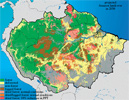
(02/27/2008) More than half the Amazon rainforest will be damaged or destroyed within 20 years if deforestation, forest fires, and climate trends continue apace, warns a study published in Philosophical Transactions of the Royal Society B. Reviewing recent trends in economic, ecological and climatic processes in Amazonia, Daniel Nepstad and colleagues forecast that 55 percent of Amazon forests will be “cleared, logged, damaged by drought, or burned” in the next 20 years. The damage will release 15-26 billion tons of carbon into the atmosphere, adding to a feedback cycle that will worsen both warming and forest degradation in the region. While the projections are bleak, the authors are hopeful that emerging trends could reduce the likelihood of a near-term die-back. These include the growing concern in commodity markets on the environmental performance of ranchers and farmers; greater investment in fire control mechanisms among owners of fire-sensitive investments; emergence of a carbon market for forest-based offsets; and the establishment of protected areas in regions where development is fast-expanding.
Amazon rainfall linked to Atlantic Ocean temperature
(02/25/2008) Climate models increasingly forecast a dire future for the Amazon rainforest. These projections are partly based on recent research that has linked drought in the Amazon to sea surface temperatures in the tropical Atlantic. As the tropical Atlantic warms, the southern Amazon — the agricultural heartland of Brazil — may see higher temperatures and less rainfall.
Large-scale Amazon deforestation or drying would have dire global consequences
(02/21/2008) A new study shows that large-scale degradation of the Amazon, either through drying or continued deforestation, would have global consequence, including worsening climate change, causing regional vegetation shifts, and increasing dust in the atmosphere.
Global warming – not el Nino – drove severe Amazon drought in 2005
(02/20/2008) One of the worst droughts on record in the Amazon was caused by high temperatures in the Atlantic rather than el Nino. The research, published in Philosophical Transactions of the Royal Society B, suggests that human-driven warming is already affecting the climate of Earth’s largest rainforest.
Climate change could dramatically change forests in Central America

(05/02/2007) Drought could cause dramatic shifts in rainforest plant communities in Central America, reports a new study published in the May 3 issue of Nature. The research shows that many rainforest plants are ill-equipped to deal with extended dry periods, putting them at elevated risk from changes in climate projected for the region.